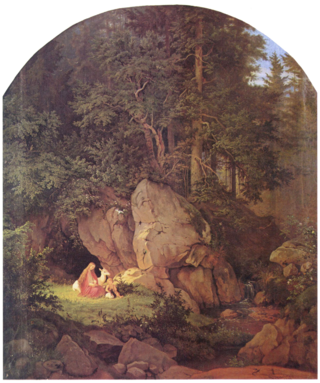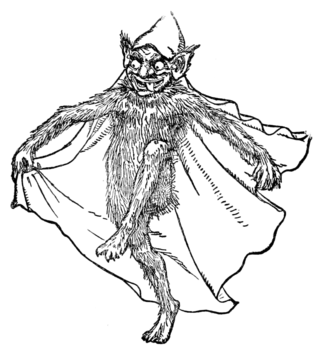Related Research Articles

A fairy is a type of mythical being or legendary creature found in the folklore of multiple European cultures, a form of spirit, often described as metaphysical, supernatural, or preternatural.
In the fantasy of J. R. R. Tolkien, the Dwarves are a race inhabiting Middle-earth, the central continent of Arda in an imagined mythological past. They are based on the dwarfs of Germanic myths who were small humanoids that lived in mountains, practising mining, metallurgy, blacksmithing and jewellery. Tolkien described them as tough, warlike, and lovers of stone and craftsmanship.

English folklore consists of the myths and legends of England, including the English region's mythical creatures, traditional recipes, urban legends, proverbs, superstitions, and folktales. Its cultural history is rooted in Celtic, Christian, and Germanic folklore.
Nordic folklore is the folklore of Denmark, Norway, Sweden, Iceland and the Faroe Islands. It has common roots with, and has been mutually influenced by, folklore in England, Germany, the Low Countries, the Baltic countries, Finland and Sapmi. Folklore is a concept encompassing expressive traditions of a particular culture or group. The peoples of Scandinavia are heterogenous, as are the oral genres and material culture that has been common in their lands. However, there are some commonalities across Scandinavian folkloric traditions, among them a common ground in elements from Norse mythology as well as Christian conceptions of the world.
The redcap is a type of malevolent, murderous goblin found in Border folklore. He is said to inhabit ruined castles along the Anglo-Scottish border, especially those that were the scenes of tyranny or wicked deeds and is known for soaking his cap in the blood of his victims. He is also known as Redcomb and Bloody Cap.
In Northern English folklore, the Barghest or Barguest is a mythical monstrous black dog with large teeth and claws, though in other cases the name can refer to a ghost or household elf, especially in Northumberland and Durham, such as the Cauld Lad of Hylton.

Swiss folklore describes a collection of local stories, celebrations, and customs of the alpine and sub-alpine peoples that occupy Switzerland. The country of Switzerland is made up of several distinct cultures including German, French, Italian, as well as the Romansh speaking population of Graubünden. Each group has its own unique folkloric tradition.
The Simonside Dwarfs, also known as Brownmen, Bogles and Duergar, are in English folklore a race of dwarfs, particularly associated with the Simonside Hills of Northumberland, in northern England. Their leader was said to be known as Heslop.
The Denham Tracts constitute a publication of a series of pamphlets and jottings on folklore, fifty-four in all, collected between 1846 and 1859 by Michael Aislabie Denham, a Yorkshire tradesman. Most of the original tracts were published with fifty copies. The tracts were later re-edited by James Hardy for the Folklore Society and imprinted in two volumes in 1892 and 1895. It is possible that J.R.R. Tolkien took the word hobbit from the list of fairies in the Denham Tracts.
Robert Surtees was a celebrated English historian and antiquary of his native County Durham.
Fenodyree in the folklore of the Isle of Man, is a hairy supernatural creature, a sort of sprite or fairy, often carrying out chores to help humans, like the brownies of the larger areas of Scotland and England.

The black dog is a supernatural, spectral, or demonic entity originating from English folklore that has also been seen throughout Europe and the Americas. It is usually unnaturally large with glowing red or yellow eyes, is often connected with the Devil, and is sometimes an omen of death. It is sometimes associated with electrical storms, and also with crossroads, barrows, places of execution and ancient pathways.

In folklore and fantasy, an enchanted forest is a forest under, or containing, enchantments. Such forests are described in the oldest folklore from regions where forests are common, and occur throughout the centuries to modern works of fantasy. They represent places unknown to the characters, and situations of liminality and transformation. The forest can feature as a place of threatening danger, or one of refuge, or a chance at adventure.
Yallery Brown is a mischievous fairy-like nature spirit in an old Lincolnshire folk tale from England, which itself is usually named after the creature.
The moss people or moss folk, also referred to as the wood people or wood folk or forest folk, are a class of fairy folk, variously compared to dwarfs, elves, or spirits, described in the folklore of Germany as having an intimate connection to trees and the forest. In German, the words Schrat and Waldschrat are also used for a moss person. The diminutive Schrätlein also serves as synonym for a nightmare creature.
A hob is a type of small mythological household spirit found in the north and midlands of England, but especially on the Anglo-Scottish border, according to traditional folklore of those regions. They could live inside the house or outdoors. They are said to work in farmyards and thus could be helpful; however, if offended they could become nuisances. The usual way to dispose of a hob was to give them a set of new clothing, the receiving of which would make the creature leave forever. It could, however, be impossible to get rid of the worst hobs.

A goblin is a small, grotesque, monstrous creature that appears in the folklore of multiple European cultures. First attested in stories from the Middle Ages, they are ascribed conflicting abilities, temperaments, and appearances depending on the story and country of origin, ranging from mischievous household spirits to malicious, bestial thieves. They often have magical abilities similar to a fairy or demon, such as the ability to shapeshift.
The Surtees Society is a text publication society and registered charity based in Durham in northern England. The society was established on 27 May 1834 by James Raine, following the death of the renowned County Durham antiquarian Robert Surtees. Raine and other former friends of Surtees created the society to honour his memory and carry on his legacy, with the focus on publishing documents relating to the region between the River Humber and Firth of Forth in the east and the River Mersey and the River Clyde in the west, the region that had once constituted the kingdom of Northumbria. Membership of the Society is by annual subscription. Members receive the book published for the year of subscription.

James Raine (1791–1858) was an English antiquarian and topographer. A Church of England clergyman from the 1810s, he held a variety of positions, including librarian to the dean and chapter of Durham and rector of Meldon in Northumberland.
Captain Sir Thomas Liddell, 1st Baronet (1578–1652) was an English politician, a member of the Liddell family which monopolized the local government of the North of England during the 16th and 17th centuries. He was one of the leading supporters of the Royalist cause in the English Civil War.
References
- ↑ Briggs, Katharine (1976). An Encyclopedia of Fairies. Pantheon Books. pp. 44–5. ISBN 0394409183.
- 1 2 Henderson, William (1879). Folklore of the Northern Counties of England and the Borders (2nd ed.) W. Satchell, Peyton & Co. pp. 251–2.
- ↑ Atkinson, Philip Folk Tales of North East England (http://viewbook.at/FolkTalesEngland)
- 1 2 Publications of the Folk-lore Society (1895), Volumen 35 , pag 79 https://books.google.com/books?id=qEANAQAAIAAJ&dq=hobbits&pg=PA388
- ↑ Taylor, George and Raine, James (1852). A Memoir of Robert Surtees. Durham: George Andrews. pp. 81–2.
- ↑ Taylor and Raine (1852), p. 94.
- ↑ Skamble, Skimble (1869). Fairy Tales. Durham: Andrews & Co. pp. 149–67.
- ↑ Bane, Theresa (2013). Encyclopedia of Fairies in World Folklore and Mythology. McFarland & Company. p. 66. ISBN 9780786471119.